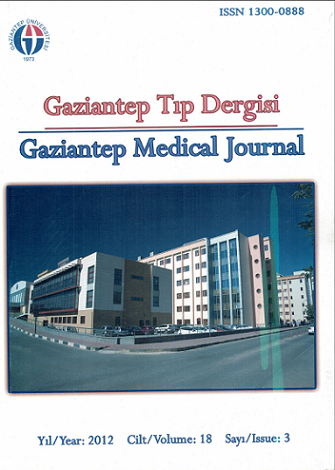Utility of blood gas values in place of biochemical values in emergency department
Keywords:
Biochemical, blood gas, electrolytes, emergency department, glucoseAbstract
It is aimed to investigate the utility of blood gas electrolyte and glucose values in place of biochemical electrolyte and glucose values in Emergency Department (ED). The group of patients, whose blood gas electrolyte , glucose and also biochemical electrolyte and glucose values were examined, These data were derived from 1007 patients at the age of 18 and older, who were admitted to Uludag University ED and whose blood gas values were examined between July 2011 and October 2011. While biochemistry K+ median was 4,2 mmol/L, blood gas K+ median was 3,86 mmol/L. When blood gas and biochemical K+ values were compared, average difference was -0,4 mmol/L (95% confidence limits: -1,5-0,7 mmol/L) and correlation coefficient was r=0.794 (p<0.001). Biochemistry Na+ median was 136 mmol/L whereas blood gas Na+ median was 138,6 mmol/L. When blood gas and biochemical Na+ values compared, average difference was 2,7 mmol/L (95% confidence limits: -3,8-9,2 mmol/L) and correlation coefficient was (r=0.836 p<0,001). Biochemistry glucose median was found out as 125,5 mg/dl whereas blood gas median was 147 mg/dl. When blood gas and biochemical glucose values were compared, average difference was 17,3 mg/dl, (95% confidence limits: -72,3-106,9 mg/dl), correlation coefficient was (r=0,904 p<0,001). Significantly positive correlation was determined between results. When blood gas electrolyte and glucose values compared with biochemical values, it was seen that they were consistent with each other. Blood gas values, which are rapid tests, might be used - especially in case of emergency, in treatment of critical patients -until biochemical values are obtained.
Metrics
References
Sterns RH, Cappuccio JD, Silver SM, Cohen EP. Neurologic sequelae after treatment of severe hyponatremia: A multicenter perspective. J Am Soc Nephrol 1994;4:1522–30.
Price CP. Medical and economic outcomes of point of care testing. Clin Chem Lab Med 2002;40:246–51.
Cox CJ. Acute care testing. Bood gases and electrolytes at the point of care. Clin Lab Med 2001;21:321–35.
Flegar-Mestric Z, Perkov S. Comparability of point of care whole blood electrolyte and substrate testing using a Stat Profile Critical Care Xpress analyzer and standard laboratory methods. Clin Chem Lab Med 2006;44:898–903.
Pungor E. Working mechanism of ion-selective electrodes. Pure & Appl Chem 1992;64:503–7.
Capasso G, Unwin R. Laboratory investigations: Electrolytes and acid–base: common fluid and electrolyte disorders In Renal. Medicine 2011;39:317-24.
Bozkurt S, Altunören O, Kurutaş EB, Doğan M. Venöz kan gazı potasyum sonuçları ile laboratuar potasyum sonuçlarının karşılaştırılması. JAEM 2012;11:73-6.
Wongyingsinn M, Suksuriyayothin S. Use of rapid ABG analyzer in measurement of potassium concentration: does it agree with venous potassium concentration? J Med Assoc Thai 2009;92:925-9.
Menchine M,Probst MA, Agy C, Bach D, Arora S. Diagnostic accuracy of venous blood gas electrolytes for identifying diabetic ketoacidosis in the emergency department. Acad Emerg Med 2011;18:1105-8.
Leino A,Kurvinen K. Interchangeability of blood gas, electrolyte and metabolite results measured with point-of-care, blood gas and core laboratory analyzers. Clin Chem Lab Med 2011;49:1187-91.
Jain A, Subhan I, Joshi M. Comparison of the point-of-care blood gas analyzer versus the laboratory auto-analyzer for the measurement of electrolytes. Int J Emerg Med 2009;2:117–20.
Downloads
Published
How to Cite
Issue
Section
License
Copyright (c) 2023 European Journal of Therapeutics

This work is licensed under a Creative Commons Attribution-NonCommercial 4.0 International License.
The content of this journal is licensed under a Creative Commons Attribution-NonCommercial 4.0 International License.














